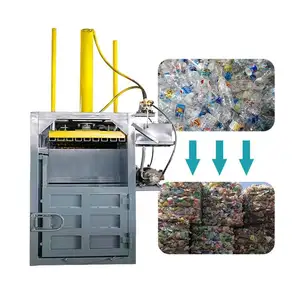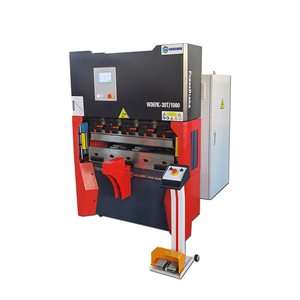(22420 products available)



































































































































































































A hydraulic small press machine is a machine that applies pressure to different materials using hydraulic force. It consists of a hydraulic pump, a pressing plate, and a power source that enables it to perform tasks like straightening, compressing, molding, forming, cutting, and removing various materials, including metal, plastic, and others.
This type of machine comes in different sizes and models, with some being manually operated, while others are automatically or electrically run. Despite the differences, they all use the same principle and mechanism to operate and apply pressure to materials. Below are some types of hydraulic press machines:
Mechanical press machine:
The machine uses a motor that drives a flywheel, which in turn moves the ram downward to apply force to the material. The force it applies can either be up to 3 times or down the center of the material. It is generally bigger than the hydraulic machine and is often used to cut and trim hydraulic fluid cylinders.
Die cutting hydraulic press machine:
The die-cut press applies pressure to cut specific shapes and designs in materials. It also uses hydraulic force and can efficiently cut intricate patterns into a material with precision. In many cases, an automated system controls the die-cut press to ensure the quality of the cut.
H-Frame hydraulic press:
The machine is shaped like the letter H and is also referred to as an H-frame shop press. It features a large frame that gives a lot of room for workers and materials to maneuver, prepare, and align, making it easier to work on with complicated tasks that require more work time. An H-frame press can carry out various tasks such as bending, straightening, forming, and others. It does this by applying pressure to whatever material is positioned on the base or table with the pressing plate moving downwards.
C-frame hydraulic press:
Similar to the H-frame press, this machine has an open frame that comes in the shape of the letter C. Though very similar to the C-frame shop press in size and shape, this smaller version is often used in workshops as standalone equipment. It can be placed conveniently at workstations where smaller, detailed work needs to be done, like in a jewelry shop or electronic repair shop. The C-frame hydraulic press applies force only in the forward direction, which makes it easier not to damage sensitive and delicate materials that need hydraulic pressing.
Specifications of hydraulic presses will vary depending on the type of machine, its application, and its capacity. Here are some specifications for small presses in general.
Horsepower and amp rating for these smaller machines will be lower. For example, a 5-ton hydraulic press might have an amp rating of 4.5. A small press will draw less power from electricity. The pressing force will also be less.
For the small pressing machine to function well over a long time, it is essential to care for it. The maintenance of any hydraulic machine is not complex. These pressing machines have no parts that move much. Putting some lubricant on the piston and seals is usually enough to maintain the machine. However, regular cleaning and lubrication are still important.
Users should clean the pressing machine to remove residual oil, dirt, debris, and dust. They should flush out any hydraulic oil and blow out any debris. Another method is to use a vacuum to get out any material in the hose or system. Use a clean cotton cloth and cleaning solvent to clean the tank. Regular cleaning will prevent any dirt getting into the hydraulic system, causing damage, and extending oil change intervals.
Users should lube the ram with any oil or grease specified in the manufacturer's manual. Lubricate the slide and rails too. Doing this will reduce wear and tear on the seals. Bushing, rail, and rams should be cleaned and lubricated from time to time.
Users should regularly check oil levels in the hydraulic tanks. They should also inspect the hoses for any cracks or bulges. Similar to the air hydraulic press machine, the oil in these small machines needs to be changed from time to time.
Small-scale hydraulic press machines are used in workshops, craft businesses, and schools. This machine helps stamp and compress materials like plastics, metals, clay, and food. Below are some common industries that use small hydraulic press machines and their applications.
Craft and DIY workshops
Many DIY and craft hobbyists use hydraulic presses to create jewelry or perform metalworks.
These machines do the following tasks:
Food industry
A hydraulic food preservation press machine helps to exert uniform pressure to extract juices or for maceration.
Small-scale presses are also used in the cheese-making industry to shape curds into cheese. Halloumi, feta, and goat cheese are some examples.
Education
In educational institutions, the hydraulic press machine is an instrumental teaching aid for understanding mechanics and physics principles, especially those related to force and pressure.
It is also used for laboratory experiments. Students can use the machine to conduct material tests and understand how pressure affects their structural strength.
Medical and healthcare
Small hydraulic presses are used to compress dressing and bandages during packing to increase shelf life.
They are also used to make dental molds, implants, prosthetics, and orthopedic devices.
Aerospace and automotive industry
Small press machines play a crucial role in molding and shaping intricate components used in aerospace and automotive parts.
They include gear blanks, copper rotor blanks, copper stator blanks, insulator discs, laminated cores, and other specialized components.
Some applications also require joining precision components through techniques like staking and press-fitting.
Construction and plumbing
A small hydraulic press machine is commonly used to make indents and join plumbing fixtures, metal sheets, and pipes.
It is an essential tool during installation and repair in construction projects.
Cosmetic packaging
Cosmetic bottles have varying cap shapes and sizes that need to be pressed to fit the bottle. Hydraulic presses help reduce cycle times and increase production rates.
Application needs analysis:
Determine the intended application and pressing materials, shapes, and sizes. Consider factors such as the desired pressing force, capacity, and specific requirements of the application. This helps to select a hydraulic press machine with suitable specifications.
Force and capacity:
Choose a hydraulic small press machine with an appropriate press force and capacity to meet the production needs. Consider factors such as the material's properties, thickness, and the desired pressure ranking.
Machine size and weight:
Choose a hydraulic small press machine whose size and weight are suitable for the available space and lifting equipment at the installation site.
Control system:
Select a small hydraulic press machine with an appropriate control system, such as manual, semi-automatic, or fully automatic control, depending on the desired automation level and operational requirements.
Optional features:
Consider additional features and accessories, such as safety guards, emergency stop devices, adjustable pressing speed, and pressing force monitoring, which can enhance the machine's performance, safety, and convenience.
By considering these factors, a suitable mini hydraulic press machine can be chosen that meets specific production requirements and provides efficient and reliable pressing operations.
Q: What is the difference between a mechanical and hydraulic small press machine?
A: Both machines apply pressure to different materials, but how they function is different. A mechanical small press machine works by transforming the motion of the motor-driven gears and wheels into a pressing motion. On the other hand, a hydraulic small press machine exerts pressure using a hydraulic system that consists of a cylinder, pump, and fluid.
Q: Does a small hydraulic press machine make noise when operating?
A: Hydraulic presses generally make noise, but not as much compared to mechanical pressing machines. Noise levels can vary depending on the machine's size, capacity, and design.
Q: What factors should custom hydraulic small press machines be considered for?
A: Factors to consider when customizing the small press machine include application requirements, working space, force capacity, frame construction, automation and control systems, cooling system, selecting material, and budgeting.
Q: What safety precautions should be taken when operating a small hydraulic press machine?
A: Always read the manufacturer's manual and follow the guidance on safe operational practices. Wear appropriate PPE (personal protective equipment) such as goggles, gloves, and face shield. Always secure the material pressing area before operating the machine. Ensure that body parts are not placed within the press area. Familiarize with the machine's features, including emergency stops and alerts.